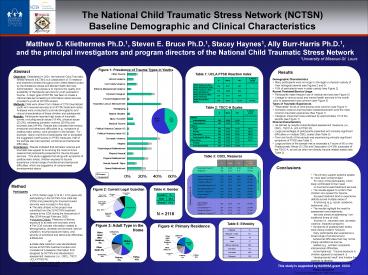The National Child Traumatic Stress Network NCTSN - PowerPoint PPT Presentation
1 / 1
Title:
The National Child Traumatic Stress Network NCTSN
Description:
... utilization, trauma exposure history, and severity of emotional and behavioral difficulties. ... CBCL, TSCC-A, UCLA PTSD RI) ... – PowerPoint PPT presentation
Number of Views:191
Avg rating:3.0/5.0
Title: The National Child Traumatic Stress Network NCTSN
1
The National Child Traumatic Stress Network
(NCTSN) Baseline Demographic and Clinical
Characteristics
Matthew D. Kliethermes Ph.D.1, Steven E. Bruce
Ph.D.1, Stacey Haynes1, Ally Burr-Harris Ph.D.1,
and the principal investigators and program
directors of the National Child Traumatic Stress
Network 1University of Missouri-St. Louis
Figure 1 Prevalence of Trauma Types in Youths
Abstract Objective Established in 2001, the
National Child Traumatic Stress Network (NCTSN)
is a collaborative of 70 research and treatment
centers throughout the United States funded by
the Substance Abuse and Mental Health Services
Administration. Its purpose is to improve the
quality and availability of therapeutic services
for youth exposed to trauma. A major goal of
NCTSN has been to create a national data set
consisting of information about services provided
to youth at NCTSN centers. Methods Data were
drawn from intakes of 2118 traumatized youth who
received services at a NCTSN treatment center.
Analyses were conducted to provide demographic
and clinical characteristics of these children
and adolescents Results Participants reported
high levels of traumatic events, including sexual
abuse (19.4), physical abuse (23.2), witnessing
domestic violence (39.9) and traumatic loss
(44.4). Results also indicated that various
emotional and behavioral difficulties (e.g.,
symptoms of posttraumatic stress), were prevalent
in the sample. For example, nearly one-third of
participants met or exceeded the suggested cutoff
scores on PTSD measures. Half of the sample also
had reported emotional and behavioral
difficulties. Conclusion Results indicated
that domestic violence and traumatic loss appear
to be among the most common reasons that
participants presented for trauma-focused
services. This study suggests that along with
symptoms of posttraumatic stress, children
exposed to trauma experience a broad range of
emotional and behavioral difficulties, which are
suggestive of compromised developmental status.
- Results
- Demographic Characteristics
- Many participants were no longer in the legal or
physical custody of - their biological parents (see Figures 2 and
3). - 19 of participants were in state custody (see
Figure 2). - Recent Treatment/Service Usage
- Participants made frequent use of medical
services (see Figure 5) - Linkage to various social and mental health
services in the month - prior to assessment was common (see Figure 5).
- Types of Traumatic Experiences
- Reportable forms of child trauma were common
(see Figure 1). - Domestic violence and traumatic loss/bereavement
were the most - common traumatic experience (See Figure 1).
- Caregiver impairment was endorsed by
approximately 1/3 of the - sample (see Figure 1).
- Clinical Characteristics
- As defined by results of standardized assessment
measures (i.e., - CBCL, TSCC-A, UCLA PTSD RI).
Table 1 UCLA PTSD Reaction Index
Table 2 TSCC-A Scales
Table 3 CBCL Measures
- Conclusions
- The primary support systems appear to have
been compromised - for many of the participants, which likely
contributed to their need - or trauma-focused treatment services.
- The results appear to confirm that children who
present for trauma- - focused treatment tend to experience deficits
across multiple areas of - functioning (e.g., social, academic,
behavioral, etc.). - The results highlight the need for assessment
and treatments - services aimed at addressing non-traditional
forms of child - trauma (i.e., traumatic loss, domestic
violence, impaired caregiver). - Symptoms of posttraumatic stress were clearly
evident however, - many participants also experience a broad
range of emotional and - behavioral difficulties that may not be
initially identified as trauma- - related (e.g., somatic complaints,
interpersonal difficulties, - noncompliance). Trauma exposure in children
appears to represent a - developmental insult and hinders the
capacity to develop - competencies in a variety of areas.
Children Aged 1½ to 5
Children Aged 6 to 18
- Method
- Participants
- 2118 children (age 3-19 M 9.19 years old)
participating in the NCTSN Core Data Set (CDS)
and presenting for trauma-focused services were
included in this study - The data utilized in this project was submitted
from the 29 NCTSN treatment centers to the CDS
during the time period of May 2004 through
February 2006. - Inclusion Criteria Presence of lifetime exposure
to at least one traumatic event. - The CDS includes information related to
demographics, domestic environment, service
utilization, trauma exposure history, and
severity of emotional and behavioral
difficulties. - Measures
- f
- Intake data collection was standardized across
all NCTSN treatment centers and consisted of a
baseline information form designed by NCTSN and
standardized assessment measures (i.e., CBCL,
TSCC, UCLA PTSD RI). - Only baseline intake data was analyzed for the
purpose of this project.
Figure 2 Current Legal Guardian
Table 4 Gender
N 2118
Table 5 Ethnicity
Figure 3 Adult Type in the Home
Figure 4 Primary Residence
This study is supported by SAMHSA grant XXXX































